
Exploramum and Explorason – Egypt, Luxor – Isis 2 Papyrus Museum – how it is made
The last week we have been in Egypt, and have been bombarded with sellers claiming to sell us ‘genuine papyrus’ artwork.
So is it real Papyrus Paintings or genuine Papyrus Paintings they offer you in the streets and markets?
However, most of it is actually dried banana leaf or other vegetable matter.
So here is our visit to Isis 2 Papyrus Museum as part of our Nile Explorer with Egypt Uncovered Tour.
And we learn how exactly Papyrus paper is really made.
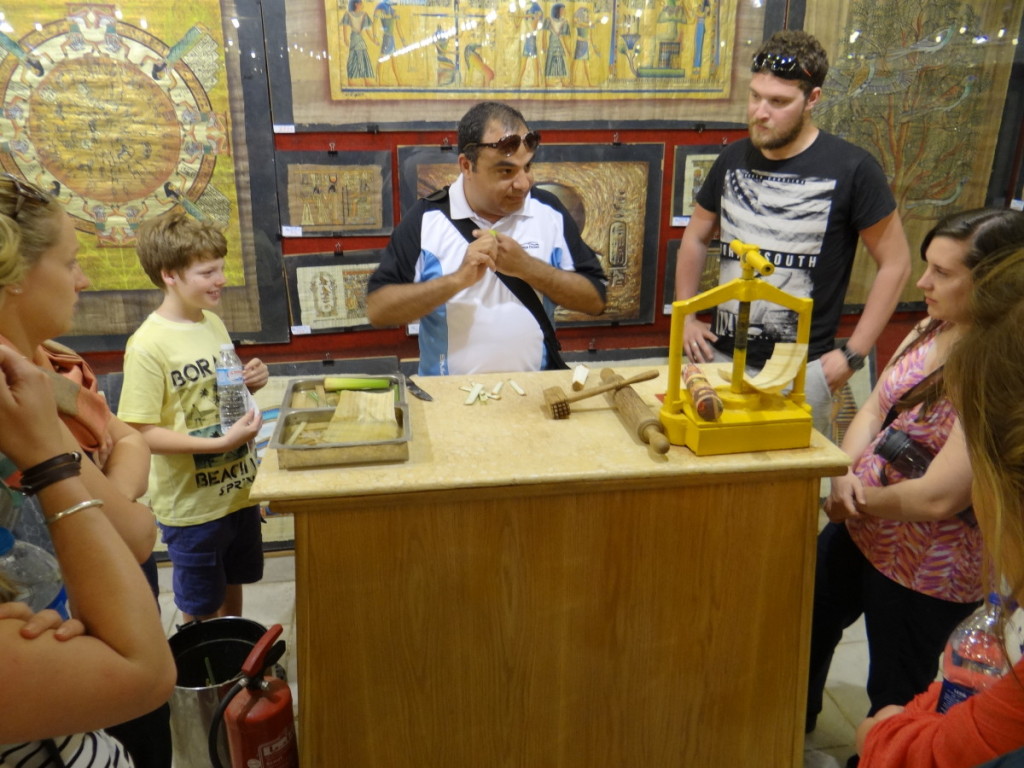
Exploramum and Explorason – Egypt, Luxor – Isis 2 Papyrus Museum – Learning the technique
Papyrus paper is made from the stem or stalk of the papyrus plant.
The outer layer is first removed, and the soft inside fiber is cut longways into thin strips. These strips are usually about 35 to 40 cm long.
The strips are then placed side by side on a piece of wet felt or fabric with the edges meeting or slightly overlapping, and then another layer of strips are then laid on top at a 90 degree right angle.
The strips may have been soaked in water long enough for softening to begin, which allows them to adhere slightly together because they are so soft, so they mold easily and mesh in form.
Another piece of damp felt or fabric is placed on the top and the two layers are hammered together, mashing the layers into a single sheet.
The sheet is then dried under pressure, sometimes using a press.
After drying, the sheet of papyrus paper is polished with some rounded object.
You can see Waleed our tour guide giving us a demonstration below.
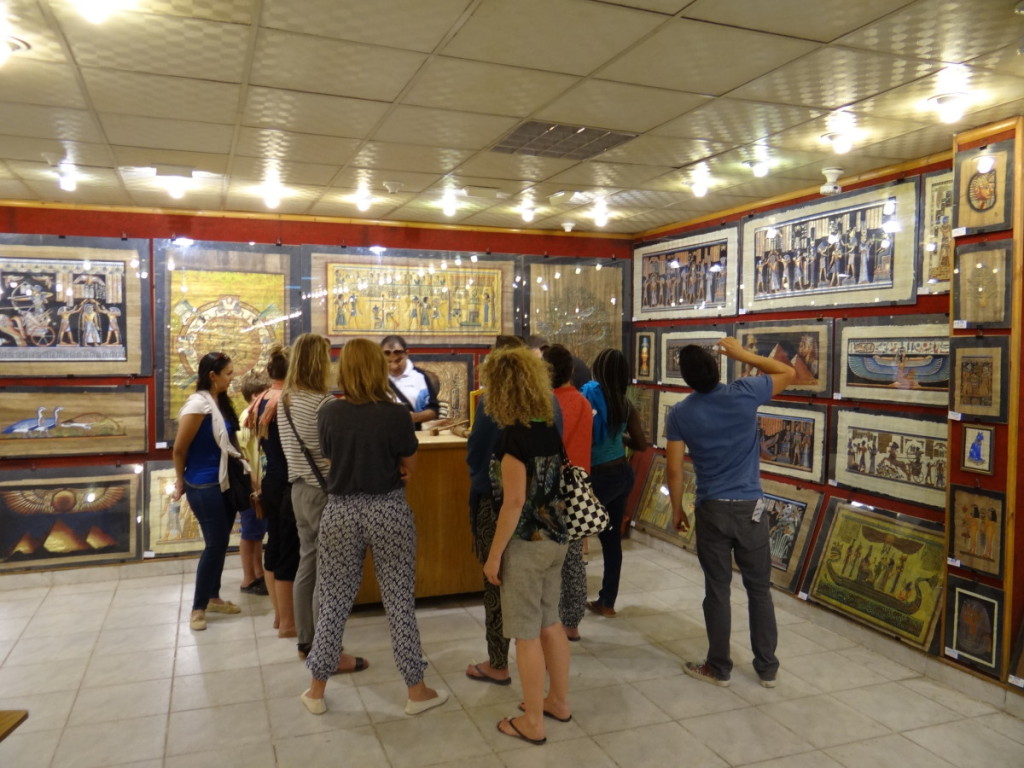
Exploramum and Explorason – Egypt, Luxor – Isis 2 Papyrus Museum – group demonstration
Sheets could be cut to fit the standard size used for art, or glued together to create a long roll.
In ancient times it was custom for a wooden stick would be attached to the last sheet in a roll, making it easier to use and to decrease the risk of damage when it was used. It was never folded, only rolled.
Thus the papyrus paper was made and is still used today.
There are a number of things to consider when purchasing papyrus art.
Be aware there is fake papyrus and it is usually banana leaf or stalk, corn husks, potatoes, eggplant, carrot, and a few other materials can also be found.
But don’t be fooled. Real papyrus is usually weightier and difficult to tear. The best way to tell is to dampen it and it won’t fall apart, but rarely can you do this with art.
There is a light and dark papyrus paper. The longer it is soaked for, the darker the paper. The lighter sheets are stronger.
Take note; reputable papyrus paper and art dealers will stamp their merchandise with the store stamp to guarantee the authenticity of the product, or give you a certificate of authenticity.
Authentic papyrus artwork is usually hand-painted and not printed by any machine, as you will find with fake papyrus artwork.
Be on the lookout for flaking of the painted surface too.
Some artists painting on large sheets may use a silk screen process for drawing the outlines and then complete the rest of the painting/art manually.
Even genuine papyrus can be found at times to be printed using a color printer.
But genuine artwork will be signed by the artist as well.
The stringy edges are also something that should be displayed outside the mount when framing.
So when we visited Isis 2 Papyrus Museum we were pleased with their huge showroom, and the fact that we walked away with was signed artwork, supplied with a guarantee, and rolled in a tube for transportation.
It is also meant to be way cheaper in Luxor than in Cairo.
So make sure you visit this great showroom if you want to buy quality papyrus artwork.
Isis 2 Papyrus Museum
Address: Hilton Road El Karnak Luxor, Luxor, Egypt
Facebook: https://www.facebook.com/pages/Isis-2-Papyrus-Museum/350862304928009

Exploramum and Explorason – Egypt, Luxor – Isis 2 Papyrus Museum – meeting the manager

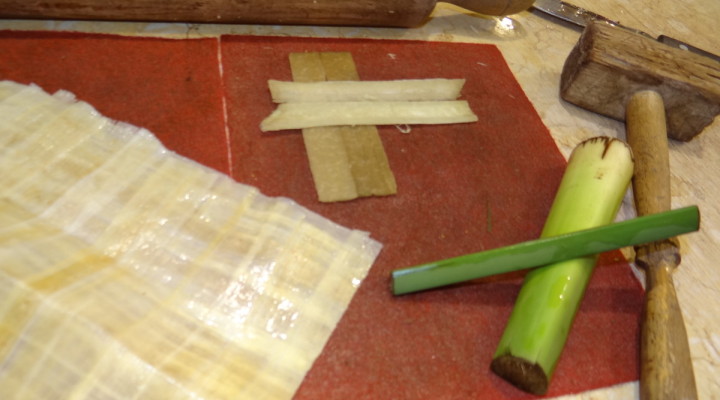
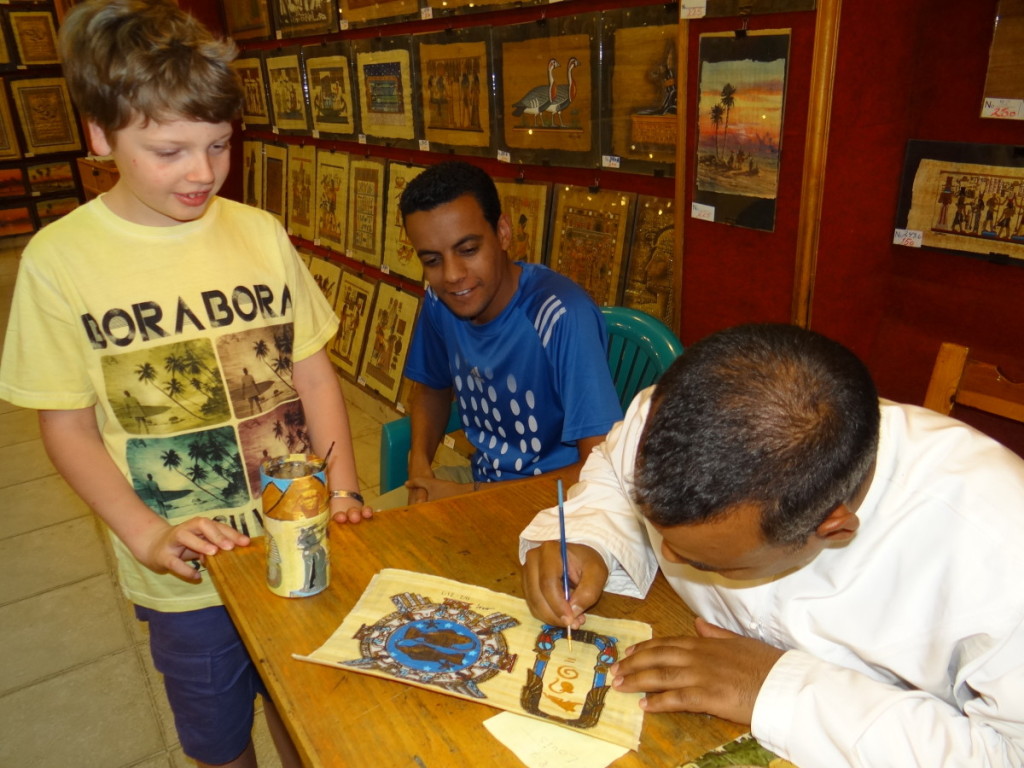
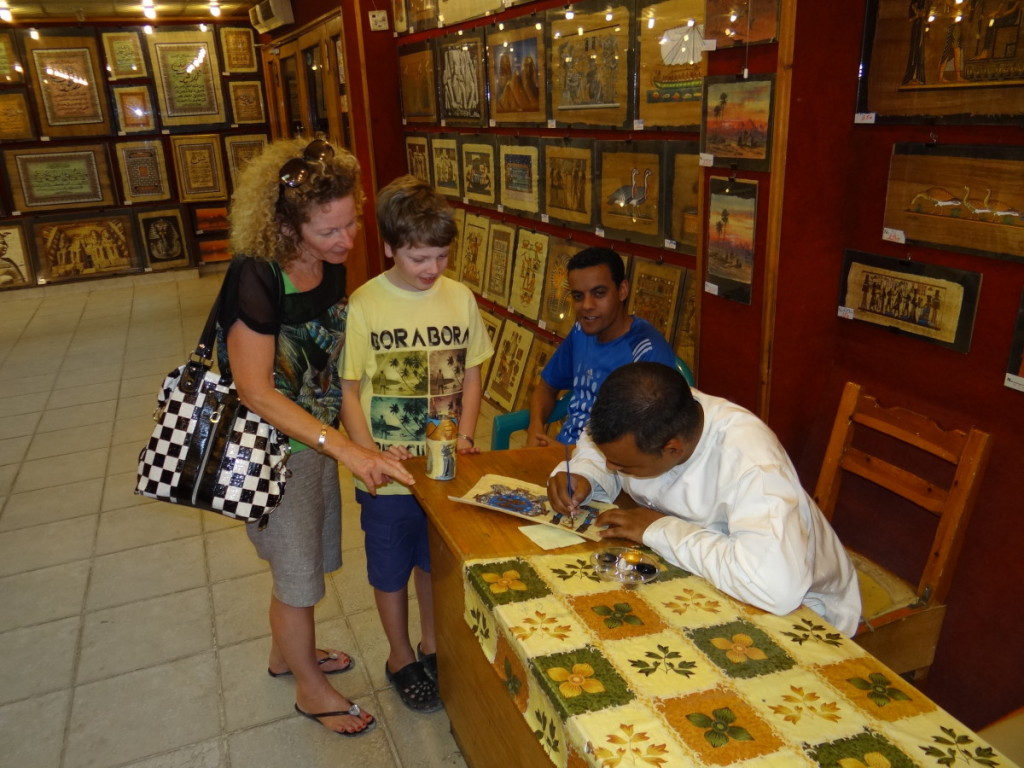
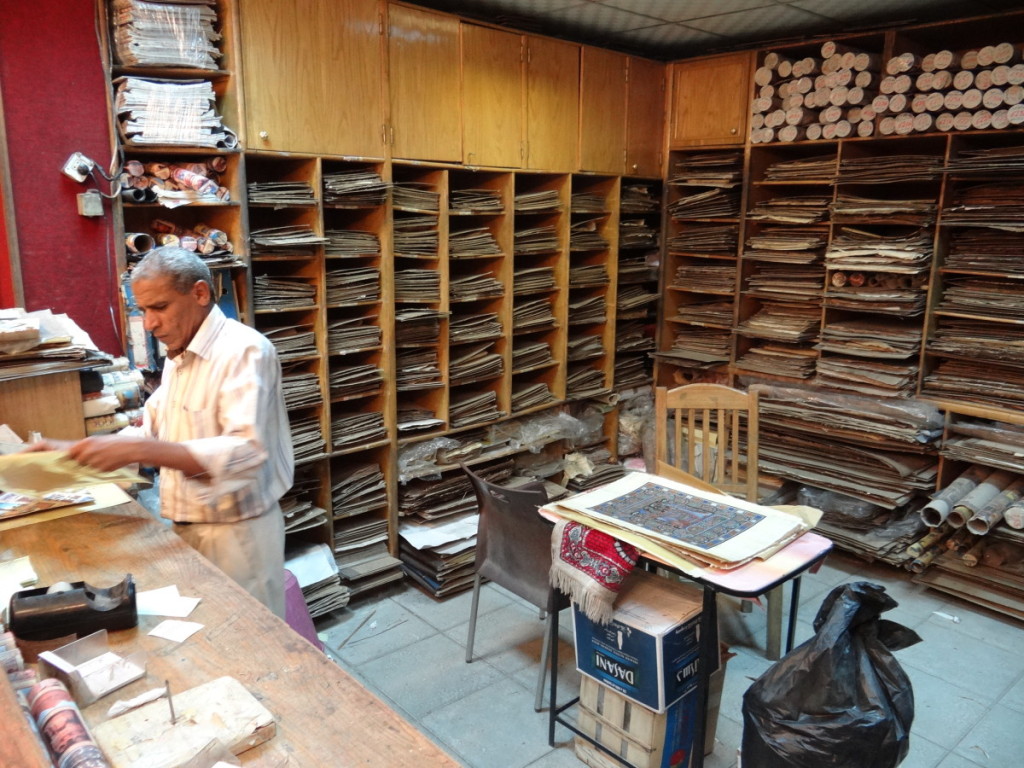
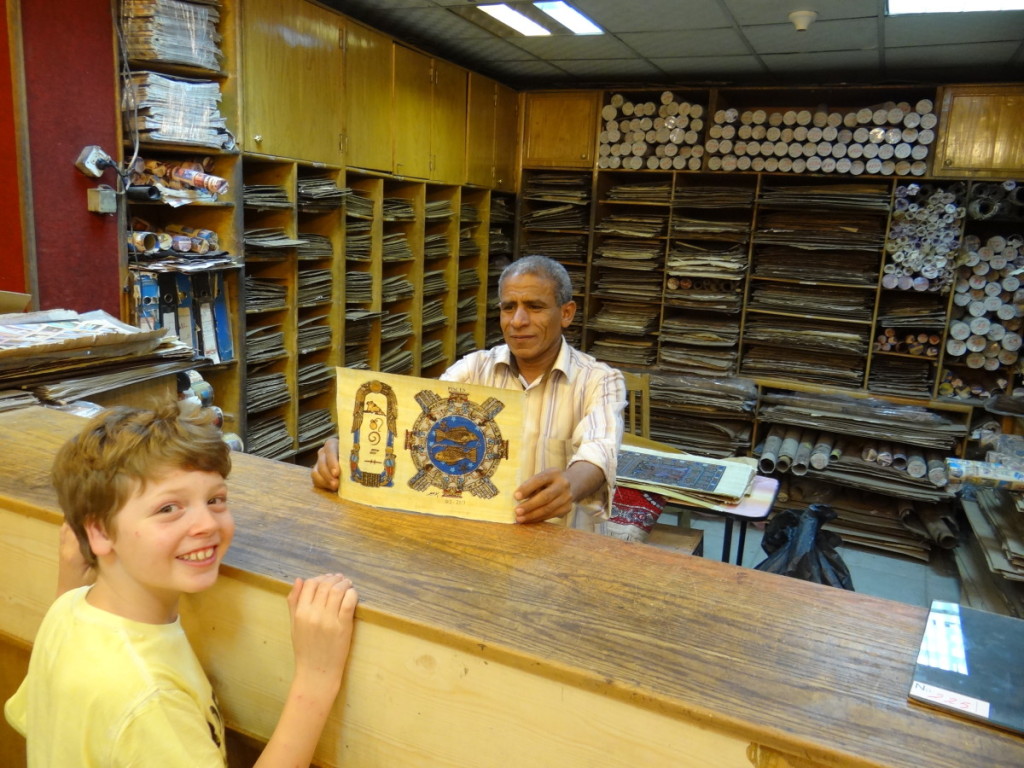

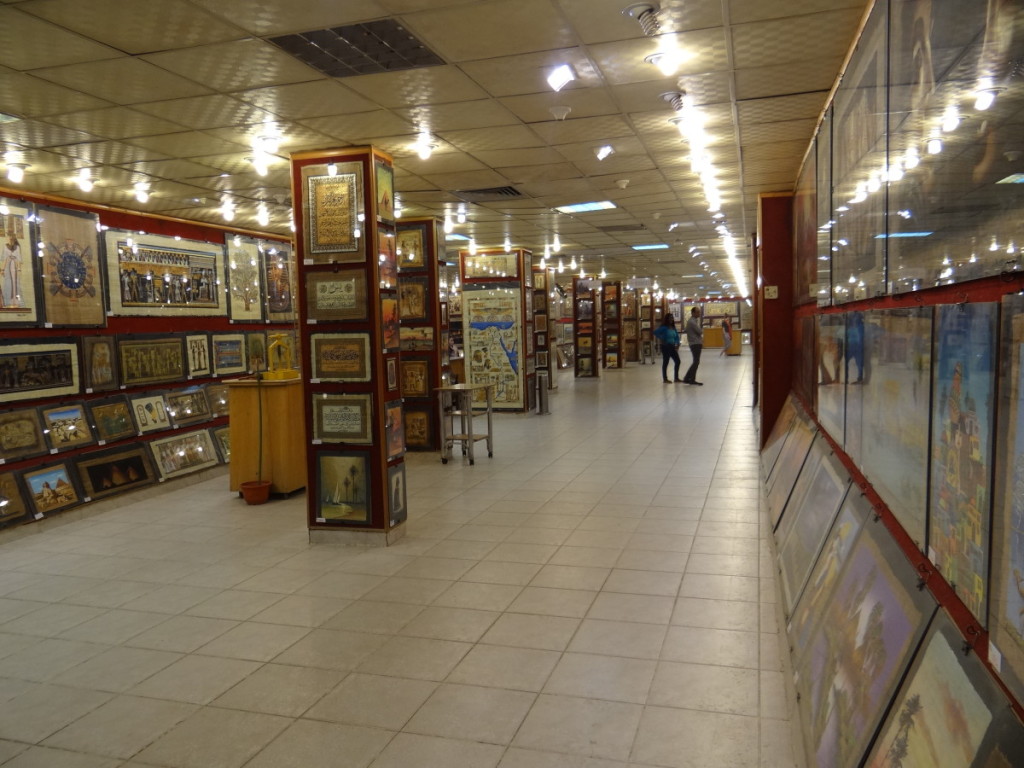












Thank you a lot
I have A papyrus painting of the Egyptian zodiac it looks authentic to me but I really wouldn’t know whats and what’s real. I also noticed that on the back of the papyrus it has a seal print but it’s partially Cut. What I can make of it .it says Sphinx P ****exhibition ..I believe.
I have a vintage papyrus my mother purchased for me in Egypt and like you, it also has something on the back but mine has more information and no seal.
You could contact the company we visited to see if they can offer you any insight?
I do know they can be worth a fortune if they are authentic.
Recent visit to Egypt…Trust me when I say most of this tour/factory with sell is a scam..,I payed 300 egp( he asked for 900) for 2 small ones at some factory in Cairo…and after got 1 big and severl small ones from a vendor also calming real papayrus they are the same quality even the same box….but the price differ is huge the big o e at the factory was 4000+ at the vendor 300 yes you read it eight over 10 times more expensive at the factory…and quess what all that creap the factory told us ,the 300egp big one the random vendor also glow in the dark also has stamp also the same box and the quality certification…,Dont get fooled..,there tho some machine ones but most vendor will tell you straight up those are machine made and are cheaper like 20 egp one medium size and they dont have box or nothing
You are right – one must be very careful
I have 2 signed artworks with gold and silver used. Beautifully framed so im wondering their value.
I hope you and your family are well. We have a papyrus painting that my Grandparents purchased years ago when they visited Egypt. It was destroyed by the executor of my Uncle’s estate. I believe it was authentic. Could you give me any information as to how we might be able to replace it with another one just like it or similar. We would want authenticity papers and the artist’s signature. Please let me know how I might send the photo and/or video. Thank you for your help with this. ~Mark and Mary Willenbrink
Hi Mary
Why not contact the gallery directly in Egypt.
I am a travel writer only, not the store – you would need to contact them directly.
Thanks